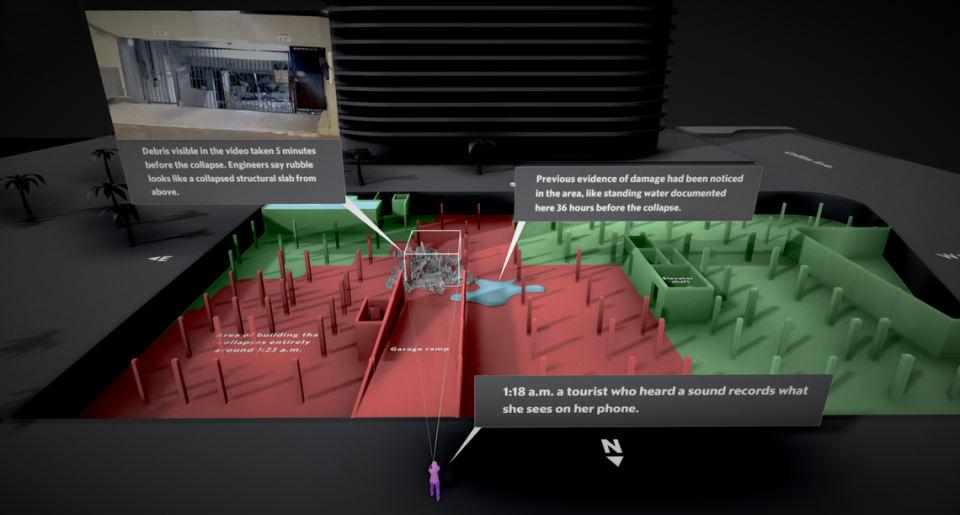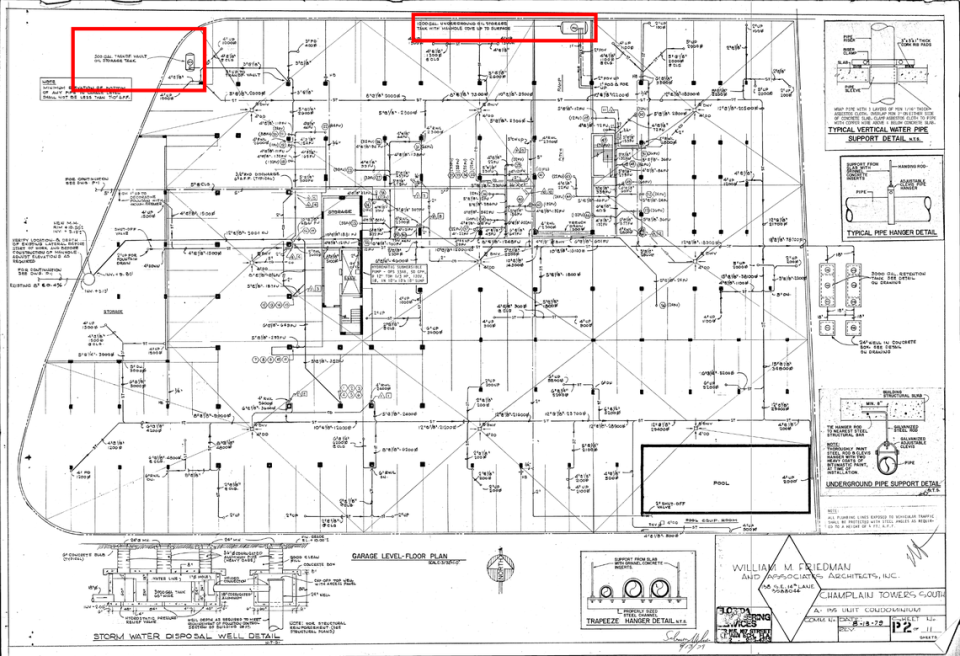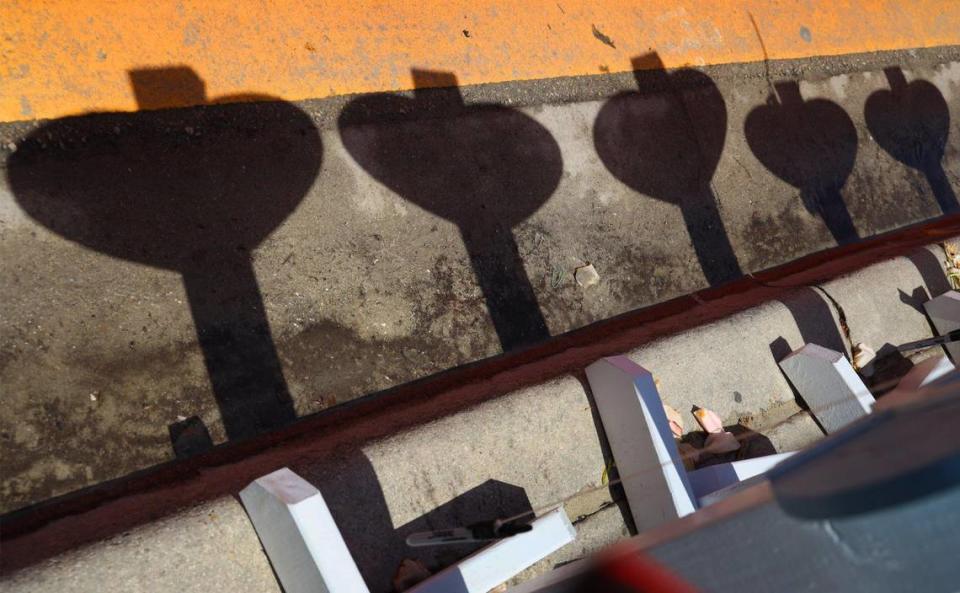Panicked Surfside 911 calls show clearer timeline of collapse, suggest possible explosion
Minutes before the Champlain Towers South condo partially collapsed in the early hours of June 24, people reported an “explosion” in the garage of the building, according to just-released recordings of emergency calls to Miami-Dade police and fire rescue. Early callers also described an “earthquake” causing the ceiling of the garage to fall in before the rest of the building went down.
“It seemed like here it was an earthquake,” said one caller at 1:17 am. “The garage, everything — seemed like something underground — everything exploded down.”
Experts interviewed by the Herald said those words — “explosion” and “earthquake” — hint at a possible trigger that could have caused the collapse of the pool deck slab, which led to the subsequent catastrophic collapse of the north wing of the building minutes later, leaving 96 confirmed dead and 11 missing and presumed dead.
“If there was an explosion — and I don’t know what could have caused it — but that could have caused that slab to fall,” said Dawn Lehman, professor of structural engineering at the University of Washington. “That could have started the progression [of the building collapse] as we know it.”
Lehman said gas lines or fuel tanks could have ignited and caused enough force to take down a structural element of a building like Champlain Towers. Then the slab falling could have caused a sound and vibration like an earthquake, she said.
Other engineers cautioned against drawing too many conclusions from the specific words used in the emergency calls.
Greg Batista, an engineer from Davie who specializes in concrete repair projects, said the “explosion” described by 911 callers could have simply been the sound of a concrete slab falling into the parking garage.
“It’s more likely than not that when the slab falls, of course it’s gonna create a loud boom,” Batista said. “You’ve got tons of concrete falling down at the same time.”
He also said an electrical explosion is unlikely to have triggered the collapse, unless it occurred near a gas tank and set off a chain reaction.
Building plans do not show obvious gas lines in the basement, however a memo from the condo manager last year described a dilapidated fuel tank near the entrance to the garage — a storage location Batista called unusual for potentially flammable materials like the fumes from diesel fuel.
The notice, sent to residents in January 2020, said that inspectors examining the fuel tank in the garage found it was “taking in water from the rusted fittings on top through repairs that had been previously attempted.”
“The water has caused algae growth in the fuel and could cause the generator to fail if it stated [sic] up,” the notice said. It added the board was requesting bids to replace the tank, but the permit would take three to six months to secure. It wasn’t immediately clear if that work was ever completed.
A spokesperson for the Miami-Dade Police Department declined to comment on whether it was aware of any preliminary evidence indicating an explosion at Champlain Towers South prior to the collapse.
Frank Rollason, director of the Miami-Dade Office of Emergency Management, said his office has received “no information and no intel, and there’s been no discussion that there’s been an explosion of some type that caused that building to come down.”
Allyn Kilsheimer, a structural engineer hired by the town of Surfside to investigate the collapse, said an explosion is “on my list of possibilities” for what could have ultimately caused the building to fall.
The only way to know, he said — other than from eyewitness accounts — is to collect evidence from the garage area to see if there is debris or “something contaminous” consistent with an explosion. Kilsheimer has not yet been able to collect that evidence.
Kilsheimer said he’s still exploring what could potentially make a fuel tank like the one stored in the Champlain Towers garage explode — and whether such an explosion could have knocked out a column or other structural element of the building.
Drawings for remediation work that was put out to bid earlier this year showed that gas service was set to be installed at the building, Kilsheimer said, but he said he doesn’t believe the building had any gas service when it collapsed.

It’s unclear whether federal investigators looking into the collapse have yet reviewed the 911 calls. A spokesperson for the U.S. Department of Commerce’s National Institute of Standards and Technology said the agency, which is staffed with some of the world’s top engineers and chemists, has not finalized its team for the Surfside disaster.
While it’s too early to say whether they would be a focal point, the calls mentioning an explosion would almost certainly be examined, potentially prompting witness interviews.
“NIST looks at any and all available information that is going to help shed light on the probable cause,” Jennifer Huergo, spokesperson for the agency, told the Herald on Wednesday.
While the pool deck slab was known to have failed first, the emergency calls also provide a clearer timeline of events. At 1:16 a.m., a breathless caller reported “a big explosion” at Champlain Towers South. At the same time, a fire alarm service called in an alarm for the building. It isn’t until 1:21 a.m. that someone reported the debris cloud — which the caller described as “smoke” — that engulfed bystanders as half the building collapsed, demolition-style.
At 1:23 a.m. another caller, who originally phoned Miami Beach police to report that “the roof collapsed in the garage,” according to the recording, instead yelled to the county dispatcher “Oh my god. The f***ing building collapsed.”
A few minutes later another shaken caller said she witnessed the pool area collapse.

“I woke up because I was hearing some noise, I couldn’t understand what was happening,” she said. “I look outside and I saw the patio [pool] area, started sinking down.”
She said she saw the “whole building” fall underground.
“There are many, many floors of the building that went down, the building just went to the sinkhole,” she said. “So there will be many, many people dead.”

The ultimate trigger will not be certain without a full investigation. Still, buildings usually don’t just fall without a nudge, regardless of their state of disrepair, experts say, making the sudden, unexplained, middle-of-the night Champlain cave-in appear unprecedented. But explosions — of gas lines or otherwise — have triggered collapses in the past.
“All of this makes a lot more sense to me. Because nothing else made sense to me,” Lehman said. “An explosion shatters concrete, unfortunately, just like we saw in Oklahoma City.”
Still, it’s possible, Batista said, that there was no particular trigger — other than years of structural problems and deterioration over time, including concrete cracking under pressure, that caused columns to give way.
“I’ve personally seen in projects that I’ve worked with that these things just collapse at a moment’s notice,” Batista said. “But nothing remotely to the extent of this damage.”
Even if the trigger for the slab failure was identified, experts say, it still does not explain why the structure on top of it subsequently came down. Lehman said a question for investigators remains: “How could we have saved the rest of the building from collapsing.”

